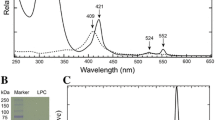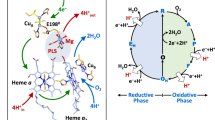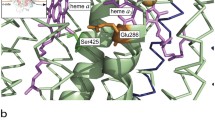Abstract
A soluble cytochrome (Cyt) c’ from thermophilic purple sulfur photosynthetic bacterium Thermochromatium (Tch.) tepidum exhibits marked thermal tolerance compared with that from the closely related mesophilic counterpart Allochromatium vinosum. Here, we focused on the difference in the C-terminal region of the two Cyts c’ and examined the effects of D131 and R129 mutations on the thermal stability and local heme environment of Cyt c’ by differential scanning calorimetry (DSC) and resonance Raman (RR) spectroscopy. In the oxidized forms, D131K and D131G mutants exhibited denaturing temperatures significantly lower than that of the recombinant control Cyt c’. In contrast, R129K and R129A mutants denatured at nearly identical temperatures with the control Cyt c’, indicating that the C-terminal D131 is an important residue maintaining the enhanced thermal stability of Tch. tepidum Cyt c’. The control Cyt c’ and all of the mutants increased their thermal stability upon the reduction. Interestingly, D131K exhibited narrow DSC curves and unusual thermodynamic parameters in both redox states. The RR spectra of the control Cyt c’ exhibited characteristic bands at 1,635 and 1,625 cm−1, ascribed to intermediate spin (IS) and high spin (HS) states, respectively. The IS/HS distribution was differently affected by the D131 and R129 mutations and pH changes. Furthermore, R129 mutants suggested the lowering of their redox potentials. These results strongly indicate that the D131 and R129 residues play significant roles in maintaining the thermal stability and modulating the local heme environment of Tch. tepidum Cyt c’.






Similar content being viewed by others
Abbreviations
- Cyt:
-
Cytochrome
- Tch. :
-
Thermochromatium
- Alc. :
-
Allochromatium
- LH:
-
Light-harvesting
- RC:
-
Reaction center
- DSC:
-
Differential scanning calorimetry
- RR:
-
Resonance Raman
References
Ambler RP, Bartsch RG, Daniel M, Kamen MD, McLellan L, Meyer TE, Van Beeumen J (1981) Amino acid sequences of bacterial cytochromes c’ and c-556. Proc Natl Acad Sci USA 78(11):6854–6857
Benini S, Rypniewski WR, Wilson KS, Ciurli S (2008) High resolution crystal structure of Rubrivivax gelatinosus cytochrome c’. J Inorg Biochem 102(5–6):1322–1328
Castillo MCG, Lou B-S, Ondrias MR, Robertson DE, Knaff DB (1994) Characterization of flavocytochrome c 552 from the thermophilic photosynthetic bacterium Chromatium tepidum. Arch Biochem Biophys 315:262–266
Cohen DS, Pielak GJ (1995) Entropic stabilization of cytochrome c upon reduction. J Am Chem Soc 117(6):1675–1677
Cusanovich MA (1971) Molecular weights of some cytochromes Cc’. Biochim Biophys Acta 236(1):238–241
Cusanovich MA, Gibson QH (1973) Anomalous ligand binding by a class of high-spin c-type cytochromes. J Biol Chem 248(3):822–834
Desbois A (1994) Resonance Raman-spectroscopy of C-type cytochromes. Biochimie 76(7):693–707
Desbois A, Lutz M (1981) Low-frequency vibrations of ferroprotoporphyrin-substituted imidazole complexes—a Resonance Raman-study. Biochim Biophys Acta 671(2):168–176
Doyle ML, Gill SJ, Cusanovich MA (1986) Ligand-controlled dissociation of Chromatium vinosum cytochrome-c’. Biochemistry 25(9):2509–2516
Ehrenberg A, Kamen MD (1965) Magnetic and optical properties of some bacterial haem proteins. Biochim Biophys Acta 102(2):333–340
Emptage MH, Zimmermann R, Que L Jr, Munck E, Hamilton WD, Orme-Johnson WH (1977) Mossbauer studies of cytochrome c’ from Rhodospirillum rubrum. Biochim Biophys Acta 495(1):12–23
Finzel BC, Weber PC, Hardman KD, Salemme FR (1985) Structure of ferricytochrome c’ from Rhodospirillum-Molischianum at 1.67-Å resolution. J Mol Biol 186(3):627–643
Fujii S, Masanari M, Inoue H, Yamanaka M, Wakai S, Nishihara H, Sambongi Y (2013) High thermal stability and unique trimer formation of cytochrome c’ from thermophilic Hydrogenophilus thermoluteolus. Biosci Biotech Bioch 77(8):1677–1681
Gibson QH, Kamen MD (1966) Kinetic analysis of reaction of cytochrome Cc’ with carbon monoxide. J Biol Chem 241(9):1969–1976
Higuchi M, Hirano Y, Kimura Y, Oh-oka H, Miki K, Wang ZY (2009) Overexpression, characterization, and crystallization of the functional domain of cytochrome c(z) from Chlorobium tepidum. Photosynth Res 102(1):77–84
Hirano Y, Kimura Y, Suzuki H, Miki K, Wang ZY (2012) Structure analysis and comparative characterization of the cytochrome c’ and flavocytochrome c from thermophilic purple photosynthetic bacterium Thermochromatium tepidum. Biochemistry 51(33):6556–6567
Hough MA, Antonyuk SV, Barbieri S, Rustage N, McKay AL, Servid AE, Eady RR, Andrew CR, Hasnain SS (2011) Distal-to-proximal NO conversion in hemoproteins: the role of the proximal pocket. J Mol Biol 405(2):395–409
Huston WM, Andrew CR, Servid AE, McKay AL, Leech AP, Butler CS, Moir JWB (2006) Heterologous overexpression and purification of cytochrome c’ from Rhodobacter capsulatus and a mutant (K42E) in dimerization region. Mutation does not alter oligomerization but impacts the heme iron spin state and nitric oxide binding properties. Biochemistry 45:4388–4395
Kamen MD, Kakuno T, Bartsch RG, Hannon S (1973) Spin-state correlations in near-infrared spectroscopy of cytochrome c’. Proc Natl Acad Sci USA 70(6):1851–1854
Kassner RJ, Kykta MG, Cusanovich MA (1985) Binding of cyanide to cytochrome c’ from Chromatium vinosum. Biochim Biophys Acta 831:155–158
Kekilli D, Dworkowski FSN, Pompidor G, Fuchs MR, Andrew CR, Antonyuk S, Strange RW, Eady RR, Hasnain SS, Hough MA (2014) Fingerprinting redox and ligand states in haemprotein crystal structures using resonance Raman spectroscopy. Acta Crystallogr D 70:1289–1296
Kimura Y, Hirano Y, Yu LJ, Suzuki H, Kobayashi M, Wang ZY (2008) Calcium ions are involved in the unusual red shift of the light-harvesting 1 Q y transition of the core complex in thermophilic purple sulfur bacterium Thermochromatium tepidum. J Biol Chem 283(20):13867–13873
Kimura Y, Yu LJ, Hirano Y, Suzuki H, Wang ZY (2009) Calcium ions are required for the enhanced thermal stability of the light-harvesting-reaction center core complex from thermophilic purple sulfur bacterium Thermochromatium tepidum. J Biol Chem 284(1):93–99
Kitagawa T, Ozaki Y, Kyogoku Y, Horio T (1977) Resonance Raman study of pH-dependent and detergent-induced structural alterations in heme moiety of Rhodospirillum rubrum cytochrome-c’. Biochim Biophys Acta 495(1):1–11
Kobayashi M, Fujioka Y, Mori T, Terashima M, Suzuki H, Shimada Y, Saito T, Wang ZY, Nozawa T (2005a) Reconstitution of photosynthetic reaction centers and core antenna-reaction center complexes in liposomes and their thermal stability. Biosci Biotech Bioch 69(6):1130–1136
Kobayashi M, Saito T, Takahashi K, Wang Z-Y, Nozawa T (2005b) Electronic properties and thermal stability of soluble redox proteins from a thermophilic purple sulfur photosynthetic bacterium, Thermochromatium tepidum. Bull Chem Soc Jpn 78:2164–2170
Lamar GN, Jackson JT, Bartsch RG (1981) Analysis of field-dependent relaxation data and hyperfine shifts of cytochrome-c’ from Rhodospirillum rubrum in terms of the high-spin iron ligation states. J Am Chem Soc 103(15):4405–4410
Lawson DM, Stevenson CEM, Andrew CR, Eady RR (2000) Unprecedented proximal binding of nitric oxide to heme: implications for guanylate cyclase. EMBO J 19(21):5661–5671
Liu LJ, Nogi T, Kobayashi M, Nozawa T, Miki K (2002) Ultrahigh-resolution structure of high-potential iron-sulfur protein from Thermochromatium tepidum. Acta Crystallogr D 58:1085–1091
Madigan MT (1984) A novel photosynthetic bacterium isolated from a Yellowstone hot spring. Science 225:313–315
Maltempo MM (1974) Magnetic state of an unusual bacterial heme protein. J Chem Phys 61(7):2540–2547
Maltempo MM, Moss TH (1976) Spin 3/2 state and quantum spin mixtures in heme proteins. Q Rev Biophys 9(2):181–215
Meyer TE, Kamen MD (1982) New perspectives on c-type cytochromes. Adv Protein Chem 35:105–212
Meyer TE, Cheddar G, Bartsch RG, Getzoff ED, Cusanovich MA, Tollin G (1986) Kinetics of electron-transfer between cytochromes-c’ and the semiquinones of free flavin and clostridial flavodoxin. Biochemistry 25(6):1383–1390
Moore GR, Pettigrew GW (1990) Cytochromes c : evolutionary, structural, and physicochemical aspects. Springer, Berlin
Moulis JM, Scherrer N, Gagnon J, Forest E, Petillot Y, Garcia D (1993) Primary structure of Chromatium tepidum high-potential iron-sulfur protein in relation to thermal-denaturation. Arch Biochem Biophys 305(1):186–192
Nagai K, Kitagawa T, Morimoto H (1980) Quaternary structures and low-frequency molecular vibrations of hemes of deoxy and oxyhemoglobin studied by resonance Raman-scattering. J Mol Biol 136(3):271–289
Niwa S, Yu LJ, Takeda K, Hirano Y, Kawakami T, Wang-Otomo ZY, Miki K (2014) Structure of the LH1-RC complex from Thermochromatium tepidum at 3.0 angstrom. Nature 508(7495):228–232
Othman S, Richaud P, Vermeglio A, Desbois A (1996) Evidence for a proximal histidine interaction in the structure of cytochromes c’ in solution: a resonance Raman study. Biochemistry 35(28):9224–9234
Pixton DA, Petersen CA, Franke A, van Eldik R, Garton EM, Andrew CR (2009) Activation parameters for heme-NO binding in Alcaligenes xylosoxidans cytochrome c ‘: the putative dinitrosyl intermediate forms via a dissociative mechanism. J Am Chem Soc 131(13):4846–4853
Ramirez LM, Axelrod HL, Herron SR, Rupp B, Allen JP, Kantardjieff KA (2003) High resolution crystal structure of ferricytochrome c’ from Rhodobacter sphaeroides. J Chem Crystallogr 33(5–6):413–424
Rawlings J, Stephens PJ, Nafie LA, Kamen MD (1977) Near-infrared magnetic circular-dichroism of cytochrome c’. Biochemistry 16(8):1725–1729
Ren Z, Meyer T, Mcree DE (1993) Atomic-structure of a cytochrome-c’ with an unusual ligand-controlled dimer dissociation at 1.8 angstrom resolution. J Mol Biol 234(2):433–445
Rubinow SC, Kassner RJ (1984) Cytochromes-c’ in their reaction with ethyl isocyanide. Biochemistry 23(12):2590–2595
Sekine F, Horiguchi K, Kashino Y, Shimizu Y, Yu LJ, Kobayashi M, Wang ZY (2012) Gene sequencing and characterization of the light-harvesting complex 2 from thermophilic purple sulfur bacterium Thermochromatium tepidum. Photosynth Res 111(1–2):9–18
Shibata N, Iba S, Misaki S, Meyer TE, Bartsch RG, Cusanovich MA, Morimoto Y, Higuchi Y, Yasuoka N (1998) Basis for monomer stabilization in Rhodopseudomonas palustris cytochrome c’ derived from the crystal structure. J Mol Biol 284(3):751–760
Sot B, Banuelos S, Valpuesta JM, Muga A (2003) GroEL stability and function—contribution of the ionic interactions at the inter-ring contact sites. J Biol Chem 278(34):32083–32090
Spiro TG, Strekas TC (1974) Resonance Raman-spectra of heme proteins—effects of oxidation and spin state. J Am Chem Soc 96(2):338–345
Spiro TG, Czernuszewicz RS, Li XY (1990) Metalloporphyrin structure and dynamics from resonance Raman-spectroscopy. Coordin Chem Rev 100:541–571
Strekas TC, Spiro TG (1974) Resonance-Raman evidence for anomalous heme structures in cytochrome c’ from Rhodopseudomonas palustris. Biochim Biophys Acta 351(2):237–245
Sturtevant JM (1987) Biochemical applications of differential scanning calorimetry. Annu Rev Phys Chem 38:463–488
Tahirov TH, Misaki S, Meyer TE, Cusanovich MA, Higuchi Y, Yasuoka N (1996) High-resolution crystal structures of two polymorphs of cytochrome c’ from the purple phototrophic bacterium Rhodobacter capsulatus. J Mol Biol 259(3):467–479
Taniguchi S, Kamen MD (1963) On anomalous interactions of ligands with Rhodospirillum haem protein. Biochim Biophys Acta 74(3):438–455
Tateishi Y, Abe T, Tamogami J, Nakao Y, Kikukawa T, Kamo N, Unno M (2011) Spectroscopic evidence for the formation of an N intermediate during the photocycle of sensory rhodopsin II (Phoborhodopsin) from Natronobacterium pharaonis. Biochemistry 50(12):2135–2143
Teraoka J, Kitagawa T (1980) Raman characterization of axial ligands for pentacoordinate and hexacoordinate ferric high-spin and intermediate-spin (Octaethylporphyrinato)iron(III) complexes—elucidation of unusual resonance Raman-spectra of cytochrome C’. J Phys Chem 84(15):1928–1935
Tezcan FA, Winkler JR, Gray HB (1998) Effects of ligation and folding on reduction potentials of heme proteins. J Am Chem Soc 120(51):13383–13388
Watson AJ, Hughes AV, Fyfe PK, Wakeham MC, Holden-Dye K, Heathcote P, Jones MR (2005) On the role of basic residues in adapting the reaction centre—LH1 complex for growth at elevated temperatures in purple bacteria. Photosynth Res 86(1–2):81–100
Weber PC (1982) Correlations between structural and spectroscopic properties of the high-spin heme protein cytochrome-c’. Biochemistry 21(21):5116–5119
Weiss R, Gold A, Terner J (2006) Cytochromes c’: biological models for the S = (3)/(2), (5)/(2) spin-state admixture? Chem Rev 106(6):2550–2579
Yoshimura T, Fujii S, Kamada H, Yamaguchi K, Suzuki S, Shidara S, Takakuwa S (1996) Spectroscopic characterization of nitrosylheme in nitric oxide complexes of ferric and ferrous cytochrome c’ from photosynthetic bacteria. Biochim Biophys Acta 1292(1):39–46
Yu LJ, Unno M, Kimura Y, Yanagimoto K, Oh-oka H, Wang-Otomo ZY (2013) Structure analysis and characterization of the cytochrome c-554 from thermophilic green sulfur photosynthetic bacterium Chlorobaculum tepidum. Photosynth Res 118(3):249–258
Acknowledgments
This work was supported by Grants-in-aid for Scientific Research (C) (24570158) (Y.K.) from the Ministry of Education, Culture, Sports, Science and Technology of Japan. We appreciate the Instrument Center of the Institute for Molecular Science for assistance of DSC measurements.
Author information
Authors and Affiliations
Corresponding authors
Electronic supplementary material
Below is the link to the electronic supplementary material.
Rights and permissions
About this article
Cite this article
Kimura, Y., Kasuga, S., Unno, M. et al. The roles of C-terminal residues on the thermal stability and local heme environment of cytochrome c’ from the thermophilic purple sulfur bacterium Thermochromatium tepidum . Photosynth Res 124, 19–29 (2015). https://doi.org/10.1007/s11120-014-0069-6
Received:
Accepted:
Published:
Issue Date:
DOI: https://doi.org/10.1007/s11120-014-0069-6




